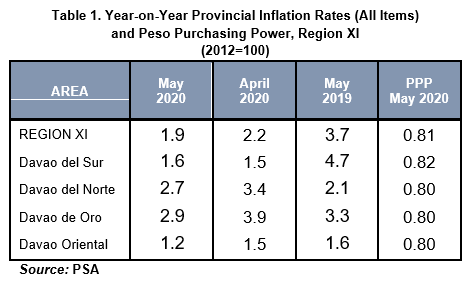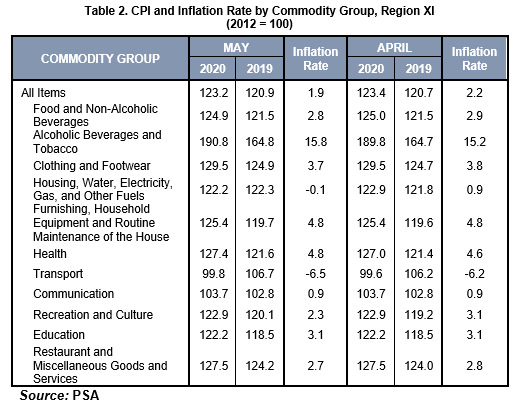Release Date :
Reference Number :
2020-012
 Davao region’s inflation lowers to 1.9 percent in May 2020. The current rate was relatively lesser as compared to the region’s inflation of the same month in the previous year at 3.7 percent. In addition, the purchasing power of the peso (PPP) retained its previous month’s value at 81 centavos (see Table 1).
Davao region’s inflation lowers to 1.9 percent in May 2020. The current rate was relatively lesser as compared to the region’s inflation of the same month in the previous year at 3.7 percent. In addition, the purchasing power of the peso (PPP) retained its previous month’s value at 81 centavos (see Table 1).Expectedly, the year-on-year provincial inflation rates decreased. However, Davao de Oro continued to have the highest inflation among the provinces in the region at 2.9 percent. This was followed by Davao del Norte at 2.7 percent. Meanwhile, Davao Oriental and Davao del Sur had lower rates (1.2 percent and 1.6 percent) with respect to the region’s inflation.
The slowdown of inflation rate in May 2020 was mainly attributed to the deceleration of index for housing, water, electricity, gas, and other fuels at -0.1 percent. Other commodity groups that also contributed to the downtrend of inflation were:
• Recreation and Culture, 2.3 percent;
• Transport, -6.5 percent; and
• Clothing and Footwear, 3.7 percent.
The indices of Education and Communication kept its previous month’s annual rate at 3.1 percent.
On the other hand, commodity groups such as Alcoholic Beverages and Tobacco; and Health were reported having a slight increase in their indices at 15.8 percent and 4.8 percent during the month (see Table 2).

Annual growth rates were reportedly higher in the indices of Vegetables, Rice, and Bread and Cereals at -3.8 percent, 0.8 percent, and 1.2 percent, respectively. Food items such as Fruits; Fish; and Sugar, Jam, Honey, Chocolate and Confectionery showed a significant decrease in their indices at 12.1 percent, 6.6 percent, and 2.6 percent, each.

The regional inflation presented in tables 4 and 5 shows that SOCCSKASARGEN (Region XII) held the highest inflation among the 17 administrative regions in the Philippines at 3.6 percent while Northern Mindanao (Region X) had the lowest inflation at 1.0 percent.

Approved for released:
PEPITO D. AMOYEN
(Chief Statistical Specialist)
Officer-in-Charge
PSA Regional Statistical Services Office XI
